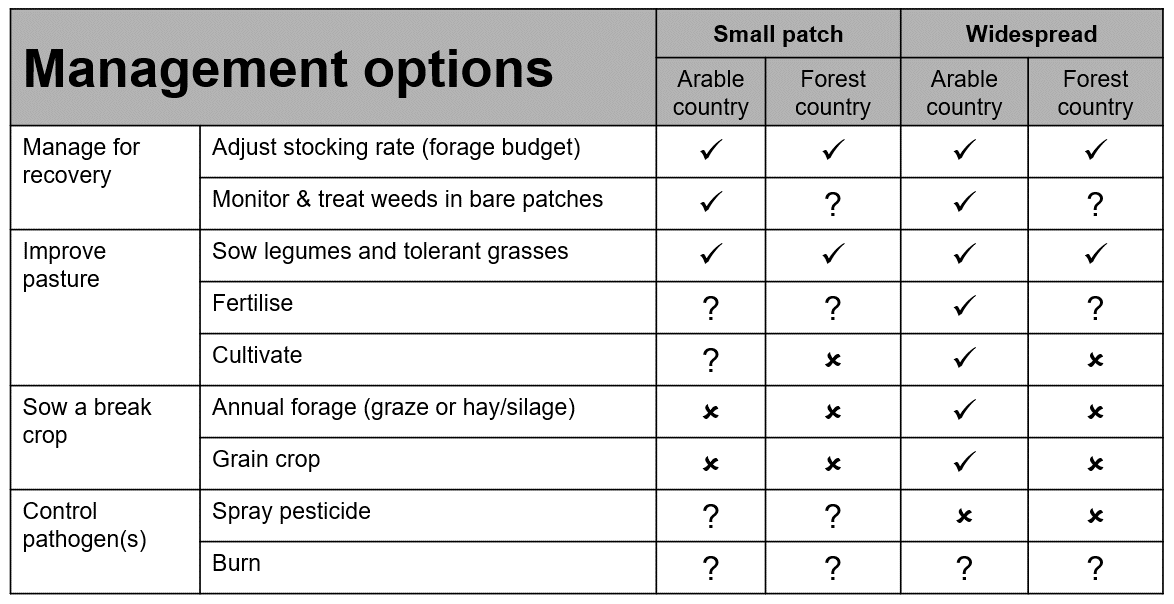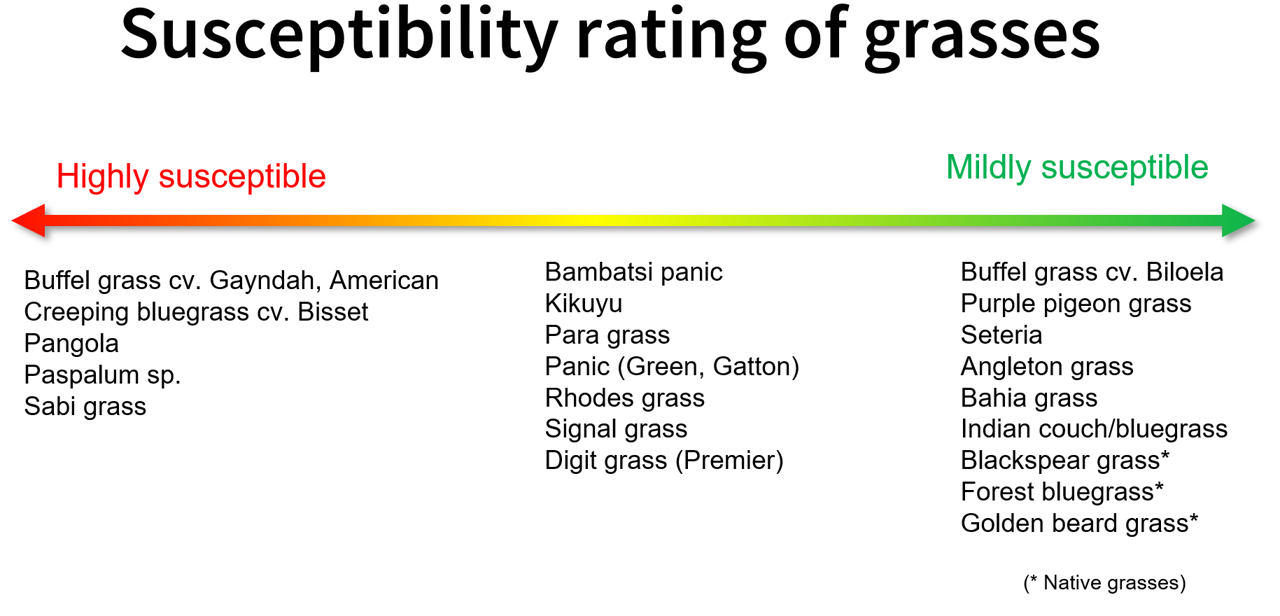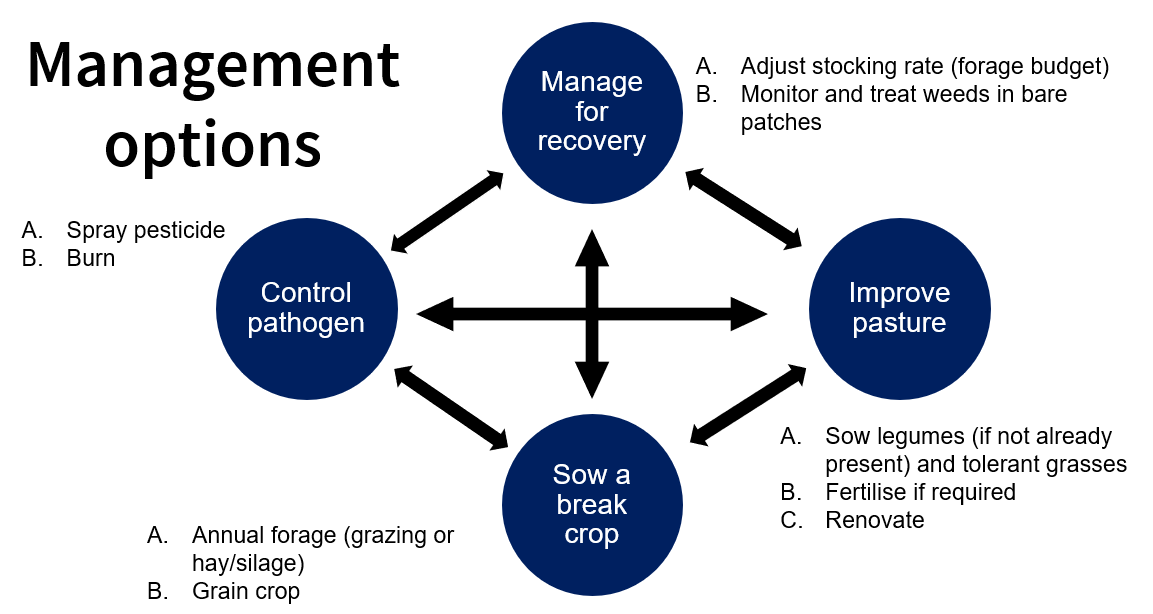Pasture dieback update 2022
After some good falls of rain recorded across Queensland, now is the time for graziers to be on the look-out for pasture dieback.
How to identify pasture dieback
Dieback causes premature death of pastures, typically in patches. Water and temperature stress, nutrient deficiency, even herbicide damage, can present similar symptoms to dieback. Other known pathogens such as fungal infections (e.g. blight on buffel grass) can also be misdiagnosed as pasture dieback. It is important to exclude these to definitively diagnose pasture dieback. The four stages of pasture dieback symptoms are:
- Yellowing and/or reddening of individual leaves, starting from the older leaves.
- Stunted, unthrifty growth of plants in patches – or in severe cases, across whole paddocks – with obvious yellowing and/or reddening of multiple leaves or the whole plant.
- Premature death, in patches or whole paddocks.
- Broadleaf plants in areas of dead pasture. Dead pasture plants are grey and can be uprooted easily.
A new pasture dieback identification guide has been recently published. Click here to download an electronic copy.
What is causing pasture dieback?
DAF is undertaking research into multiple potential casual agents. These include the plant microbiome (which analyses the presence of fungi, bacteria, viruses, insects, protozoa using DNA techniques), insects such as pasture mealybug and nematodes, and soil nutrient levels. At this stage the likely cause of pasture dieback is a pathogenic organism. There is potential more than one are interacting, for example, a virus transmitted by a sap sucking insect. It’s the combination of environmental conditions and management practices that create an environment for a pathogen(s) to affect the pasture i.e. high biomass improved-grass pastures are typically affected by pasture dieback.
What options do I have to manage pasture dieback?
DAF is undertaking field-based research to determine effective management options. Based on research outcomes, graziers now have multiple management options to consider depending on the specific situation. Management options are grouped into four categories:
-
Manage for recovery
Some paddocks are recovering where the new pasture re-establishes from the soil-seedbank. The fastest recovery occurs when stock numbers are matched to the available pasture (i.e using a forage budgeting approach) and where weeds have been controlled. Both practices accelerate recovery by allowing young seedlings to quickly establish without being restricted by grazing or competing for moisture with weeds.
-
Improve the pasture
Pasture improvement can be undertaken by sowing legumes and tolerant grasses, fertilising, renovating, or a combination. Renovating the whole pasture through cultivation can break a pathogen cycle and accelerate nutrient cycling to provide a healthier, nutrient-rich environment for new seedlings to thrive. Likewise, fertiliser (after a nutrient soil test is conducted) will supply nutrient(s) to maximise the new pasture’s productivity. Grazier experience and DAF research trials demonstrate legumes are unaffected by pasture dieback. Economic research also demonstrates legumes significantly improve business profitability. There are legumes suitable for all areas and soil types across Queensland – there are no excuses not to plant legumes if not already in the paddock!
-
Sow a break crop
A break crop, such as annual grain or forage crop, can be used in suitable country to break a pathogen cycle and generate short-term feed supply. A forage crop could be grazed, baled, or used for silage depending on the need and availability of machinery. The intention is to sow a break crop for 1-2 years then return the paddock to a perennial pasture.
-
Treat a pathogen
The last option includes spraying an insecticide or using fire to control a pathogen. Insecticide application has not produced beneficial outcomes in DAF research trials. These trials also demonstrate the effectiveness of the beneficial (predatory or parasitic) insects – these need to be encouraged and not disadvantaged by applying insecticides. Likewise burning (in spring) has also produced limited benefits in trials however several graziers have anecdotally reported that late wet-season mosaic burns have provided temporary benefits. Based on these outcomes, and uncertainties about the practicalities and effectiveness of insecticide application in commercial situations, most graziers are better off choosing another option. However, if spraying an insecticide is considered necessary for pasture mealybug control, multiple products are available via emergency permits issued by the Australian Pesticides and Veterinary Medicine Authority (APVMA). The application requirements on the permit must be strictly adhered to ensure legal use of the product.
More information
For more information please contact the DAF customer call centre on 13 25 23 and talk to your local beef extension officer or pasture agronomist. Other resources are available here.

